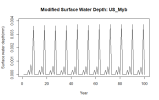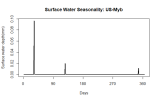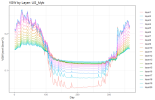hannah0304
New Member
Hello,
I am currently running a single-point run for the US-Myb(Mayberry wetland) site with CLM-FATES.
Even though the site is defined as a permanent wetland(AmeriFlux), the model result shows very little surface water on the site.


This is the plot of seasonal volumetric soil water at the site by layer.

In creating surface dataset, I have specified the percent clay(13%) and sand(35%) as given in the literature(https://doi.org/10.1029/2019GB006251),
and set baseflow_scalar = 0 and use_bedrock=.true.
I believe somehow all the water may be draining from the site so the site is not being inundated as it should be.
I would like to check the initial soil condition but I am not sure where and what to check.
Or, if there is any other suggestions regarding this issue, I would really appreciate them.
The main problem I would like to solve is to simulate the site as a permanent wetland with sufficient surface water.
Thank you.
I am currently running a single-point run for the US-Myb(Mayberry wetland) site with CLM-FATES.
Even though the site is defined as a permanent wetland(AmeriFlux), the model result shows very little surface water on the site.


This is the plot of seasonal volumetric soil water at the site by layer.

In creating surface dataset, I have specified the percent clay(13%) and sand(35%) as given in the literature(https://doi.org/10.1029/2019GB006251),
and set baseflow_scalar = 0 and use_bedrock=.true.
I believe somehow all the water may be draining from the site so the site is not being inundated as it should be.
I would like to check the initial soil condition but I am not sure where and what to check.
Or, if there is any other suggestions regarding this issue, I would really appreciate them.
The main problem I would like to solve is to simulate the site as a permanent wetland with sufficient surface water.
Thank you.

